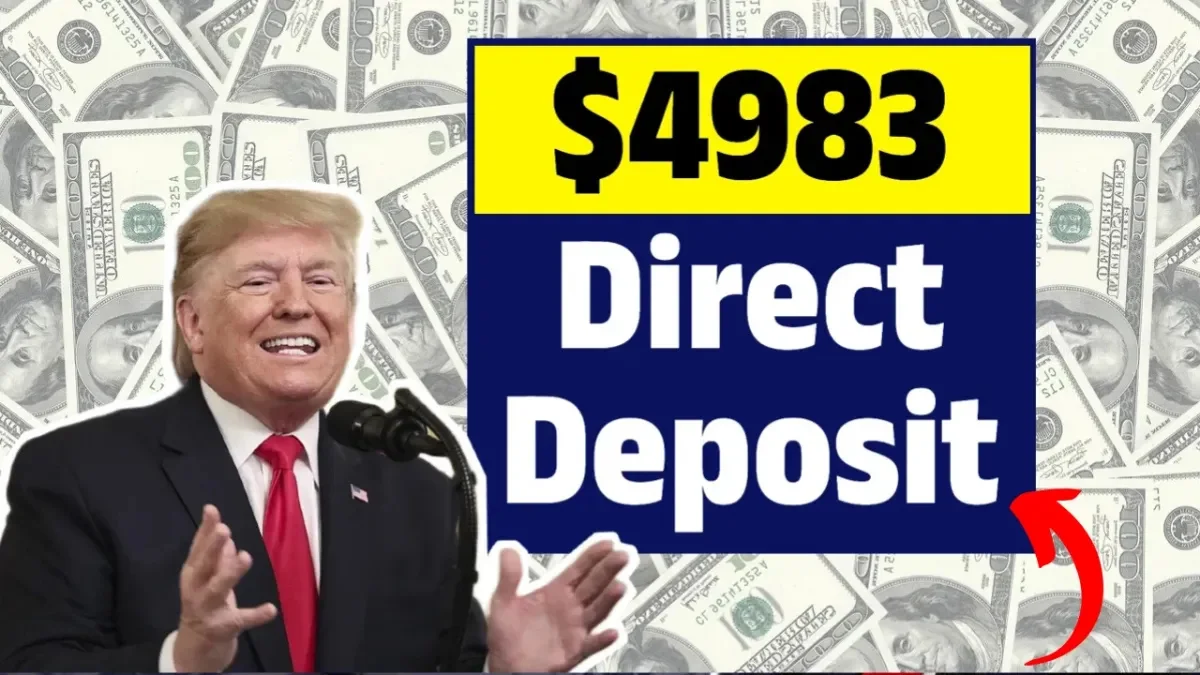$4,983 Direct Deposit:As the holiday season approaches, many Americans are closely monitoring their bank accounts for signs of relief—and this November 2025, a potential direct deposit of $4,983 could be the boost millions have been waiting for. Amid rising living costs, this new payment initiative is designed to help working families, seniors, and low-income households cope with financial stress before the year ends.
Here’s the full details on what this $4,983 direct deposit means, who’s eligible, when to expect payments, and how to ensure you receive your payment without delay.
What is a $4,983 direct deposit?
A $4,983 direct deposit is a federal payment initiative the U.S. government is considering to assist citizens most affected by inflation and rising expenses. Although it’s not officially called a “stimulus check,” it functions much like a stimulus check—providing direct financial relief through the Internal Revenue Service (IRS).
The payment amount, $4,983, is an average calculation designed to cover essential household costs like rent, groceries, and utilities for one to two months. It is expected to help middle- and low-income families who have suffered the brunt of high prices until 2025.
If approved, these funds will be automatically distributed via direct deposit, paper check, or prepaid debit card, depending on how the individual previously interacted with the IRS.
Who is eligible for the $4,983 direct deposit?
Although official guidelines may vary slightly when finalized, eligibility criteria are expected to be similar to previous relief programs. The following groups are likely to be eligible:
- Single taxpayers with an adjusted gross income (AGI) less than $75,000.
- Married couples filing jointly with an AGI less than $150,000.
- Household heads with annual incomes less than $112,500.
- Social Security (SSI/SSDI), VA, and low-income benefit recipients, even if they haven’t filed taxes for 2024.
Those with incomes above these limits may receive a reduced payment, and tax payments may gradually phase out as income increases.
Additionally, non-taxpayers—individuals who don’t typically file tax returns—may also be eligible if they receive benefits from programs like Social Security or Veterans Affairs.
When Will the $4,983 Payments Arrive?
The IRS is expected to release payments in phases throughout November 2025, beginning in the second week of the month.
Here’s the tentative payment schedule based on previous IRS disbursement timelines:
1. Direct Deposit Payments
-
First Round: Begins November 12, 2025 — for taxpayers with active bank details on file with the IRS.
-
Second Round: Between November 18 and November 22, 2025, targeting Social Security and SSI recipients.
-
Final Deposits: By November 28, 2025, for remaining eligible individuals.
2. Paper Checks
-
Mailing Start Date: Around November 25, 2025.
-
Delivery Window: Late November through early December 2025, depending on postal service schedules.
3. EIP Debit Cards
-
Issued: Between November 26 and December 5, 2025, for select recipients without bank accounts.
The IRS will prioritize direct deposit payments to ensure quicker delivery, while paper checks may take a few extra weeks.
How will the payment be sent?
The IRS will issue a direct deposit of your $4,983 using your latest tax filing information or benefit payment method. It’s as follows:
- Direct Deposit: Sent directly to your bank account – the fastest and most secure method.
- Paper Check: Sent to your most recently filed address.
- EIP Debit Card: A prepaid card that will be sent to those who don’t have active banking details.
To avoid delays, make sure your address and banking information are updated on IRS.gov before the end of October 2025.
IRS Instructions for the $4,983 Payment
The IRS emphasizes that there will be no need to apply separately for this payment. Instead, citizens should take the following steps:
- Ensure your 2024 tax return is filed to confirm eligibility.
- Use the IRS’s “Get My Payment” tool (when updated) to monitor the status of your payment.
- Keep your banking and mailing information up-to-date to avoid delays or returned checks.
- Beware of fraud. The IRS will never contact you via text, email, or phone to ask for personal or financial information.
- Monitor IRS.gov for official updates and announcements about the payment program.
Why this payment is important
Inflation continues to put pressure on household budgets, making it difficult for many Americans to meet everyday expenses in 2025. The $4,983 direct deposit is intended to provide more concrete and immediate financial assistance than previous relief rounds.
For seniors on fixed incomes, families balancing multiple jobs, and individuals recovering from medical or job-related hardships, this payment could mean paying bills, avoiding debt, or even saving for future emergencies.
As one financial expert said, “This is about helping people stay stable—not just surviving.”
FAQs
1. Is the $4,983 direct deposit confirmed?
As of now, it’s under federal review, but reports from the Treasury and IRS suggest a strong likelihood of rollout in November 2025 pending congressional approval.
2. Who qualifies for the payment?
Most taxpayers earning below $75,000 (single) or $150,000 (joint) are eligible, along with Social Security and VA beneficiaries.
3. Do I need to apply?
No. Payments will be sent automatically by the IRS based on 2024 tax returns or federal benefit records.
4. How will I know if I’m getting paid?
Once payments begin, you can check the IRS “Get My Payment” tracker to view your deposit date or mailing status.
5. Will the payment affect my Social Security or SSI benefits?
No. The $4,983 direct deposit will not impact your benefit eligibility or taxable income.
6. What should I do if I don’t receive it?
Wait a few business days after your expected date, then contact the IRS or check their official website for reissue instructions.

